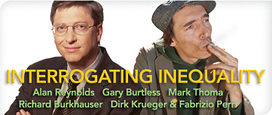Lead Essay
A headline in today’s Wall Street Journal reads “Fed Chief Warns of Widening Inequality.” Bernanke worries that inequality erodes tolerance of the “dynamism” that lays the golden eggs of “economic progress.” But is inequality widening at all? Cato Institute senior fellow Alan Reynolds has his doubts. Following up his own controversial Wall Street Journal op-ed, a Cato Institute policy forum, and a new Cato policy paper, Reynolds in this month’s lead essay digs yet deeper into the mysteries of the official numbers and comes up with … not much: “If there were any [good] data showing a significant and sustained increase in the inequality of disposable income, consumption, wages, or wealth since 1988,” Reynolds concludes, “I suspect someone would have shared it with us by now.”
Response Essays
Gary Burtless agrees that analysts of the American income distribution should “take seriously some of Reynolds’s criticisms of the data on income disparities.” “Reynolds points to some serious problems,” Burtless concedes, “and in many cases fair-minded experts will agree with him.” Nevertheless, Burtless dissents sharply from Reynolds’s larger claim that inequality apparently stopped increasing in the late 1980s. “Income inequality was higher at the end of the 1980s than it was in the beginning of that decade,” he states, “and it was higher in 2005 than it was in 1989.” According to Burtless, Reynolds can reach his unorthodox conclusion only by manipulating the evidence. “The problem is,” Burtless charges, “he is harshly critical of data series that do not support his views, while he is usually silent about equal or more serious problems with data sets that show little change in inequality.”
In his response to Alan Reynolds, Mark Thoma invites us to “step back” and survey the wider picture of data and expert opinion on income inequality. The verdict? Fed Chairman Ben Bernanke, and the consensus generally, has got this one right. “The preponderance of evidence and of professional opinion,” writes Thoma, “clearly indicates that inequality has been rising since [at least] 1988.” Like Burtless, Thoma finds little in Reynolds’ analysis to agree with, describing his main points as “either too inconsequential to change the inequality picture,” suffering from “an incomplete presentation of the evidence, or rebutted by other work.” Thoma then goes a step further, pointing to new evidence suggesting that income inequality might be even greater than currently estimated.
Invoking Kurosawa and Derrida, Richard Burkhauser dives into the contested complexities of the Current Population Survey data on household income. His conclusion: “Over the 1990s business cycle the entire distribution moved to the right with little or no change in income inequality. Since 1989 household income inequality has risen very little and much less than in the previous decade. This is very good news that matters.” Burkhauser admits that the CPS data are not well suited to tracking trends for the top 1 percent of earners. “But does this really matter?” he asks. “Our economy is not a zero sum game. My gain does not mean your loss or vice-versa. I know of no evidence that increases in the incomes of the top 1 percent of our population are the root cause of the challenges faced by those at the other end of the distribution.”
Dirk Krueger and Fabrizio Perri suggest that we shift our attention away from inequality in current incomes. “[I]f one is ultimately interested in the distribution of well-being across U.S. households,” they write, “the object of study ought to be the joint distribution of lifetime consumption and leisure across them.” Unfortunately, good data on lifetime consumption are not available. However, citing Milton Friedman and Franco Modigliani, Krueger and Perri contend that “if households can borrow and lend on financial markets, then there is a strong link between the lifetime resources of a household (sometimes also called its permanent income) and its current consumption.” And the trends in current consumption data show that “the increase in income inequality in the U.S. has been much more pronounced than the corresponding increase in consumption inequality.”
The Conversation
Related at Cato
» Has U.S. Income Inequality Really Increased? by Alan Reynolds
» When Inequality Matters by David Schmidtz
» The Cost of Reducing Economic Inequality [pdf] by Edgar K. Browning and William R. Johnson
»The Impact of Social Security Reform on Low-Income Workers by Jagadeesh Gokhale

